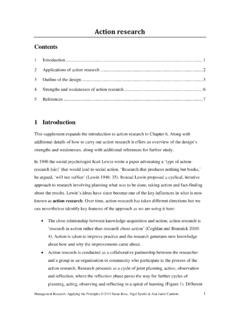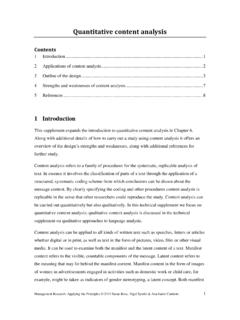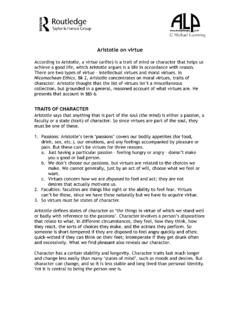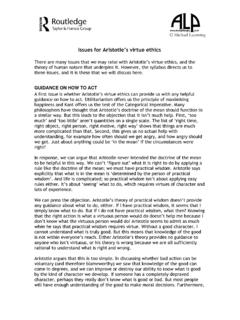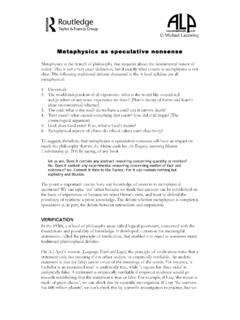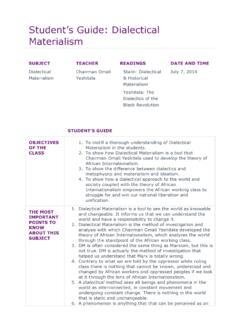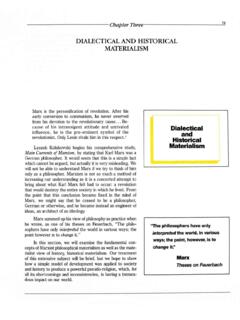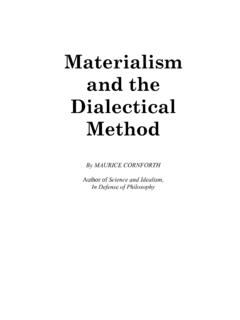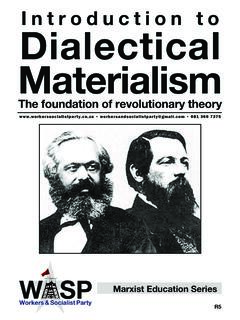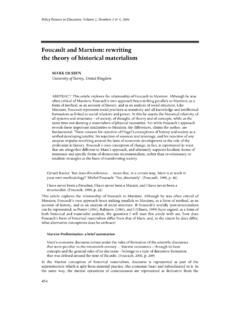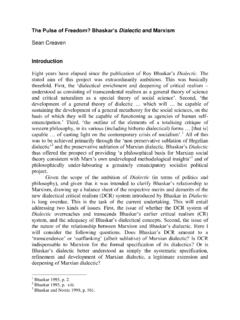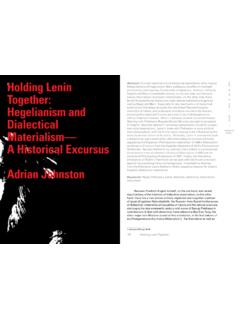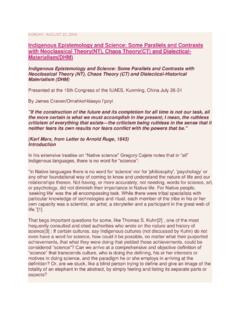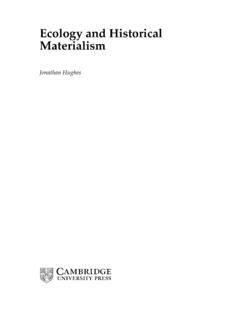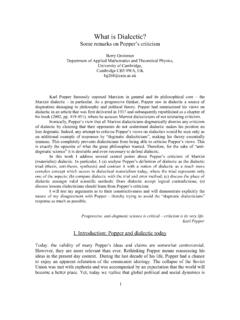Transcription of Materialism
1 From the Routledge Encyclopedia of Philosophy Materialism George J. Stack Philosophical Concept Materialism is a set of related theories which hold that all entities and processes are composed of or are reducible to matter, material forces or physical processes. All events and facts are explainable, actually or in principle, in terms of body, material objects or dynamic material changes or movements. In general, the metaphysical theory of Materialism entails the denial of the reality of spiritual beings, consciousness and mental or psychic states or processes, as ontologically distinct from, or independent of, material changes or processes. Since it denies the existence of spiritual beings or forces, Materialism typically is allied with atheism or agnosticism.
2 The forms of Materialism extend from the ancient Greek atomistic Materialism through eighteenth- and nineteenth-century scientifically based theories, to recent sophisticated defences of various types of Materialism 1. Materialism Materialism is the general theory that the ultimate constituents of reality are material or physical bodies, elements or processes. It is a form of monism in that it holds that everything in existence is reducible to what is material or physical in nature. It is opposed to dualistic theories which claim that body and mind are distinct, and directly antithetical to a philosophical idealism that denies the existence of matter. It is hostile to abstract objects, if these are viewed as more than just a manner of speaking (see Abstract objects).
3 An implication of Materialism is that the diverse qualitative experiences we have are ultimately reducible to quantitative changes in objects or in our physiological functioning. All the properties of things, including persons, are reducible to properties of matter. Although the terms referring to psychic states such as intention, belief, desire and consciousness itself have a different sense and use than terms referring to material events, a consistent materialist would deny that mentalistic terms have reference to anything other than physical events or physiological changes in our brains. The enormous advances in the sciences have contributed storehouses of empirical data that are often used to support Materialism .
4 Many philosophers have been attracted to Materialism both because of its reductive simplicity and its association with scientific knowledge. 2. Ancient Greek atomism Although Leucippus is credited with inventing the atomic theory of matter in the fifth century bc, it was Democritus (fourth century bc) who developed a systematic theory of atomistic Materialism . This theory states that matter is composed of separate and minute elements that are uncuttable (atoma), that these elements move in empty space or the void . Atoms differ only in shape and volume, and all change occurs by the transfer through direct contact of movement from atoms in motion. These elementary entities are lacking in secondary qualities and are indestructible.
5 Democritus held that things are hot or cold, sweet or bitter, or have different colours by convention . In reality, there are atoms and the void . The essentials of early atomism were retained in Epicurus physics, with the exception that Epicurus ascribed freedom to atoms in their movement through space. Epicurean Materialism is lucidly expressed in the philosophic poem byLucretius, De rerum natura (On the Nature of Things), in the first century bc. This popularization of Epicurean thought did much to keep alive both atomistic Materialism and what is already recognizable as a naturalistic understanding of humans and world (see Epicureanism). 3. Modern Materialism During the first half of the seventeenth century the atomistic Materialism of the Greco-Roman period was revived in a paradoxical way by Pierre Gassendi.
6 He appreciated the scientific interpretation of nature and the methods of science but, at the same time, preserved the Christian idea of the immortality of the soul and conceived of God as the creator of the atoms. The English philosopher Thomas Hobbes presented a systematic theory of nature and human nature that was largely, though not completely, materialistic. Apart from attributing drive or conatus to human action and sensation, Hobbesvirtually banished the concept of incorporeal substance . In theory and sentiment Hobbes was a materialist thinker, although not a consistent one. The early eighteenth century saw the publication of the first of many works that defended a materialistic and mechanistic interpretation of mankind s nature on the basis of physiological theory.
7 In L Homme machine (1748) Julien de La Mettrie, a philosophical physician, described human beings as self-moving mechanisms and sought a neurological basis for mental activity. An advance on previous attempts to develop a systematic Materialism is Paul d Holbach s 1770 Syst me de la nature (The System of Nature). Here, a consistent naturalistic Materialism is expounded in that cognitive and emotive states are reduced to internal material modifications of the brain . Though not calling it such, d Holbach presents a form of physiological determinism. With the rapid growth of the sciences, the astronomical discoveries ofCopernicus, the theories of Galileo, and the systematic conception of nature in the physical theory of Isaac Newton, naturalistic interpretations of a variety of phenomena became more and more prevalent.
8 This scientifically founded picture of reality lent greater plausibility to the principles of materialistic theory. The astronomer and mathematician Pierre Laplace (1749 1827) produced a sophisticated astronomical theory which, he thought, illustrated that a supermind, knowing all the states and conditions of every existing entity, could predict the total state of the cosmos in the next moment. When Napoleon I was shown a copy of Laplace s work, he is supposed to have commented on the absence of any mention of God. Laplace replied, I have no need of that hypothesis . Laplace s mechanistic Materialism became, in the hands of many thinkers, the definitive explanatory principle of all events.
9 The formulation of the biological theory of evolution by means of natural selection by Charles Darwin virtually eliminated teleological explanations of biological phenomena and thereby buttressed material and physical interpretations of organic development. With the advances in chemistry achieved by Lavoisier (1743 94) in France and John Dalton (1766 1844) in England, the reductive analysis of natural phenomena to chemical substances, elements and processes bolstered the empirical, naturalistic and materialistic interpretations of phenomena. During the nineteenth century many philosophical thinkers sought to build theories on the foundation of scientific facts, principles or laws.
10 The historical Materialism developed by Marx andEngels sought to formulate laws of social, economic and historical development, but did not defend metaphysical Materialism (see dialectical Materialism ). The general appeal of Materialism in the nineteenth century is shown by the popularity of the 1855 work by Ludwig B chner, Kraft und Stoff (Force and Matter), which passed through sixteen editions. Although philosophically crude, it is an accessible compendium of popular Materialism . In 1852, Jacob Moleschott had defended the reduction of force to matter, the doctrine of the conservation of matter, and a species of objective relativism in Der Kreislauf des Lebens (The Cycle of Life).
